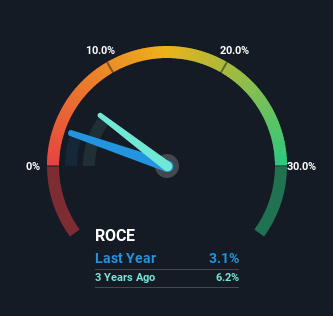- Saudi Arabia
- /
- Oil and Gas
- /
- SASE:4030
National Shipping Company of Saudi Arabia (TADAWUL:4030) May Have Issues Allocating Its Capital

What financial metrics can indicate to us that a company is maturing or even in decline? More often than not, we'll see a declining return on capital employed (ROCE) and a declining amount of capital employed. Basically the company is earning less on its investments and it is also reducing its total assets. So after we looked into National Shipping Company of Saudi Arabia (TADAWUL:4030), the trends above didn't look too great.
Return On Capital Employed (ROCE): What is it?
If you haven't worked with ROCE before, it measures the 'return' (pre-tax profit) a company generates from capital employed in its business. Analysts use this formula to calculate it for National Shipping Company of Saudi Arabia:
Return on Capital Employed = Earnings Before Interest and Tax (EBIT) ÷ (Total Assets - Current Liabilities)
0.031 = ر.س481m ÷ (ر.س22b - ر.س6.7b) (Based on the trailing twelve months to March 2022).
Therefore, National Shipping Company of Saudi Arabia has an ROCE of 3.1%. In absolute terms, that's a low return and it also under-performs the Oil and Gas industry average of 8.0%.
View our latest analysis for National Shipping Company of Saudi Arabia

Historical performance is a great place to start when researching a stock so above you can see the gauge for National Shipping Company of Saudi Arabia's ROCE against it's prior returns. If you'd like to look at how National Shipping Company of Saudi Arabia has performed in the past in other metrics, you can view this free graph of past earnings, revenue and cash flow.
What Does the ROCE Trend For National Shipping Company of Saudi Arabia Tell Us?
In terms of National Shipping Company of Saudi Arabia's historical ROCE movements, the trend doesn't inspire confidence. About five years ago, returns on capital were 8.7%, however they're now substantially lower than that as we saw above. And on the capital employed front, the business is utilizing roughly the same amount of capital as it was back then. This combination can be indicative of a mature business that still has areas to deploy capital, but the returns received aren't as high due potentially to new competition or smaller margins. If these trends continue, we wouldn't expect National Shipping Company of Saudi Arabia to turn into a multi-bagger.
While on the subject, we noticed that the ratio of current liabilities to total assets has risen to 31%, which has impacted the ROCE. Without this increase, it's likely that ROCE would be even lower than 3.1%. Keep an eye on this ratio, because the business could encounter some new risks if this metric gets too high.
The Bottom Line On National Shipping Company of Saudi Arabia's ROCE
All in all, the lower returns from the same amount of capital employed aren't exactly signs of a compounding machine. Long term shareholders who've owned the stock over the last five years have experienced a 19% depreciation in their investment, so it appears the market might not like these trends either. That being the case, unless the underlying trends revert to a more positive trajectory, we'd consider looking elsewhere.
If you'd like to know more about National Shipping Company of Saudi Arabia, we've spotted 5 warning signs, and 3 of them make us uncomfortable.
For those who like to invest in solid companies, check out this free list of companies with solid balance sheets and high returns on equity.
Valuation is complex, but we're here to simplify it.
Discover if National Shipping Company of Saudi Arabia might be undervalued or overvalued with our detailed analysis, featuring fair value estimates, potential risks, dividends, insider trades, and its financial condition.
Access Free AnalysisHave feedback on this article? Concerned about the content? Get in touch with us directly. Alternatively, email editorial-team (at) simplywallst.com.
This article by Simply Wall St is general in nature. We provide commentary based on historical data and analyst forecasts only using an unbiased methodology and our articles are not intended to be financial advice. It does not constitute a recommendation to buy or sell any stock, and does not take account of your objectives, or your financial situation. We aim to bring you long-term focused analysis driven by fundamental data. Note that our analysis may not factor in the latest price-sensitive company announcements or qualitative material. Simply Wall St has no position in any stocks mentioned.
About SASE:4030
National Shipping Company of Saudi Arabia
The National Shipping Company of Saudi Arabia, together with its subsidiaries, purchases, sells, and operates vessels for the transportation of cargo in the Kingdom of Saudi Arabia.
Excellent balance sheet with proven track record.

